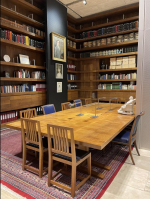December is a month upon which the archivists always look fondlyl it is the anniversary of the month we completed the move of over 5km of shelving of archives and nearly 2,000 reference books to our new home at New Court in 2011.
The Archive Reading Room at New Court was designed to be a visible and impressive space. It is situated on the exact location that Nathan Mayer Rothschild (1777-1836) took up residence in London over 200 years ago. It is incredible to think how many people may have trodden this path; financiers, statesmen and Royalty. In Nathan’s time, he and his clerks at New Court would have kept records and ledgers out of necessity; they needed for example, to know what had previously been said to their agent in Australia or the price of gold in the previous six months. Kept amongst the safety deposit boxes of clients, and in clerks’ offices, this collection of archives and volumes has remained mostly untouched and intact. Today we keep records for use by the academic research community and to support the modern global business by celebrating the past relationships and achievements of the firm. The records help us understand past decisions, help inform the future and continue to surprise us daily; a window into the past.
The purpose of The Archive
During the Second World War, Senior Partner Anthony de Rothschild (1887-1961), concerned about threats of destruction, sought to secure a place of refuge for the firm's archives. Victor, 3rd Lord Rothschild (1910-1990) offered up his family mansion at Tring Park in Hertfordshire to be used by N M Rothschild & Sons as a repository for the safe keeping of documents and valuables outside London.
The Rothschild Archive was established as a research archive in 1978 by Victor, 3rd Lord Rothschild (1910-1990). Having spent many years at Cambridge University and working in different sectors outside of banking, Victor saw the potential in the records of his own family firm as an academic resource, and brought the archives back to New Court from the places to which they had been scattered. Once the archive was established, there came a need for someone to manage it. Hence the creation of the post of the first archivist. At first, the archive collection wasn’t advertised as such, but later pamphlets, academic articles placed in journals and websites were utilised as methods of outreach. Over the years the number of users increased; the informational value of the archive collection started to become recognised and dedicated space was required to host visitors and house the archives in optimal conditions to prevent damage and deterioration of this precious resource. In 1999 the ownership of the archive collections was transferred to The Rothschild Archive Trust, an independent body of family members and advisers committed to securing the future of the collection and to developing its use by the academic community. The purpose of the Archive today is to collect, preserve and promote the archives of the Rothschild businesses and family. To achieve this, the Trustees of The Rothschild Archive administer the Archive as an independent charitable trust in purpose-built premises made available within the offices of the London business.
The Archive Reading Room, New Court
The Reading Room plays a key role in the work of the Archive; it welcomes academic researchers, group visits, and business clientele. In the ten years it has been hosting visitors we would like to think that much of the 5km worth of archives has also visited the Reading Room, a ‘day out’ from the purpose-built climate-controlled store in which they usually reside. Exhibitions in the Reading Room’s display cases change regularly and have included subjects such as horticulture, the tea business, horse-racing, fashion history, and leisure activities; things you may not assume to find in a business archive. The exhibitions serve to showcase the depth and breadth of the collection and the archivists pride themselves on being able to find something of interest or relevance to our vast array of visitors.
The furniture of the room is equally as interesting, being the work of Robert Thompson of Yorkshire, known as 'Mouseman’. Each piece of furniture crafted by the firm is embellished with a mouse, as a signature of the company. We often invite our guests to discover each of our twelve mice 'hidden' within the room. The bookshelves, table and chairs were crafted from twenty oaks (from trees that were mere saplings when Nathan Mayer Rothschild arrived in St.Swithin's Lane in 1809) and are a magnificent sight to behold. Many visitors often remark on the wonderful smell of the room – a heady mixture of wood and history.
Recently, for a period of time, the Reading Room fell silent. Visited only for security reasons, it stood and waited for the day visitors would once again return. The day the archivists stepped back into the room was like a warm embrace from an old friend. Welcoming visitors back has been a controlled measure, but a very happy experience. The Archive collection is both needed and appreciated; after all, looking at a digital image on a screen can never quite compete with holding a piece of 200-year-old history in your hands. We hope in the coming months to welcome more visitors, old and new, to the Reading Room to discover the treasures held by The Rothschild Archive.
For further information about the installation of the Reading Room in 2011 see ‘Mice in the Reading Room' by Natalie Attwood, Deputy Archivist, in The Rothschild Archive Review of the Year: April 2011-March 2012
For information about the Robert Thompson commission for the Archive Reading Room, see Robert Thompson Newsletter, Winter 2011.
The Rothschild Archive London, Reading Room furniture by Robert Thompson, 2011






















